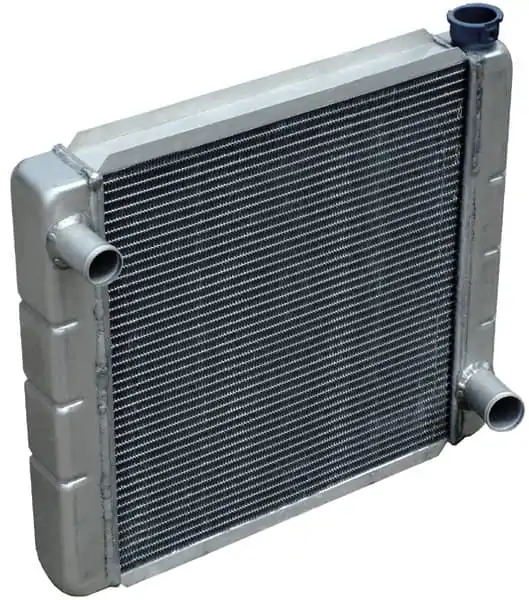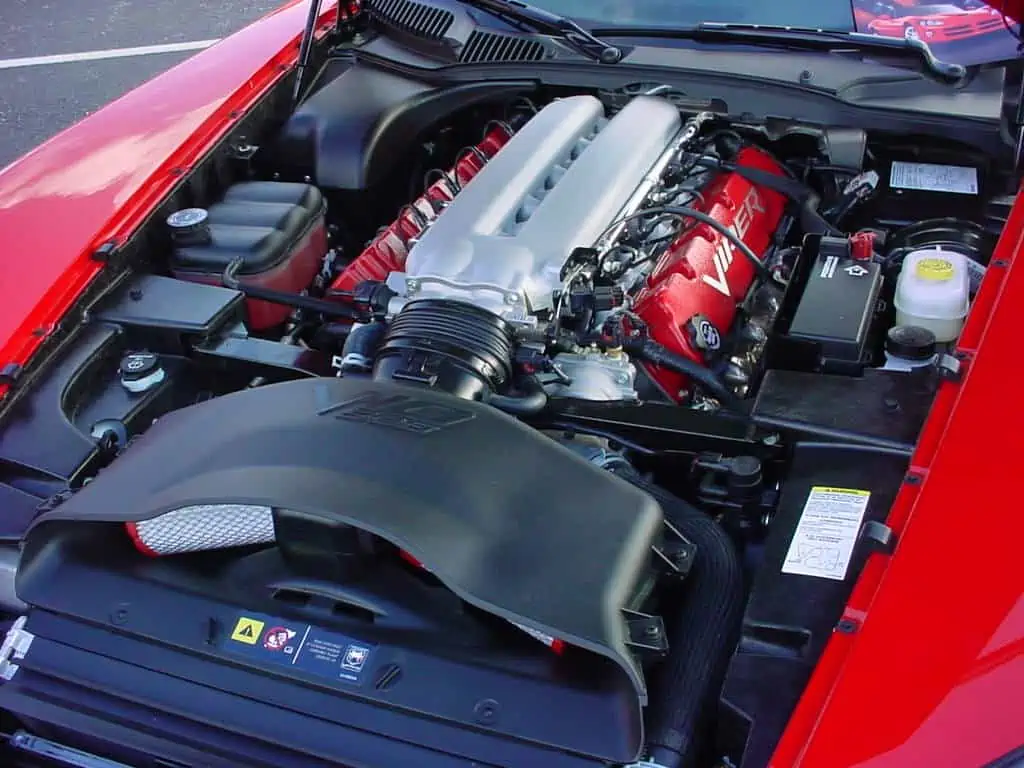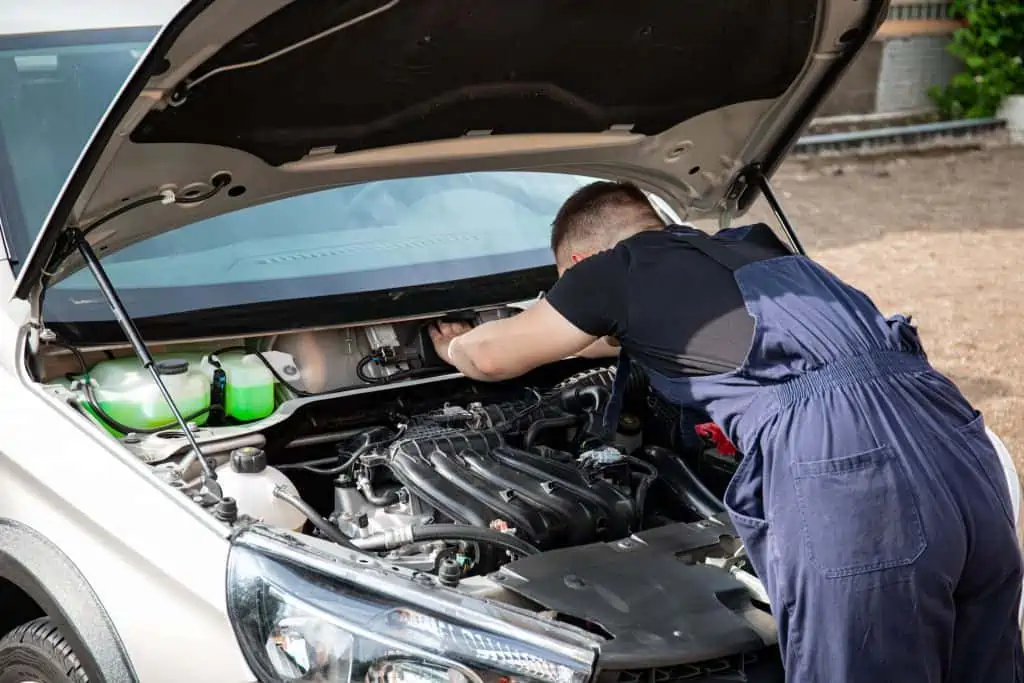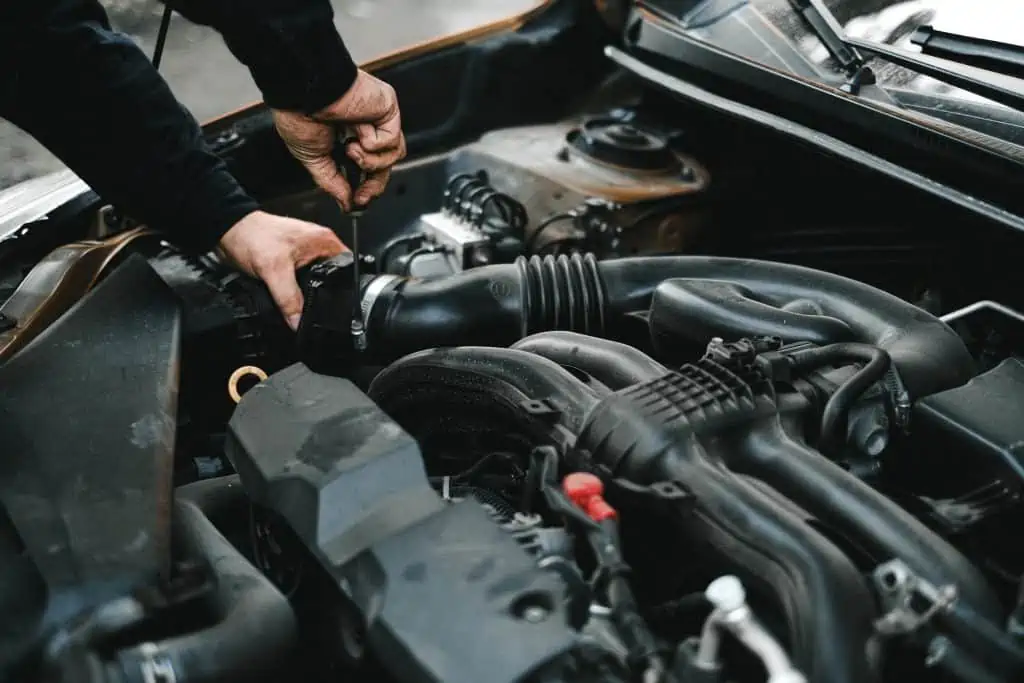Every cooling system in a car is designed by the manufacturer to withstand a particular pressure range. The coolant hose could break if you use a radiator cap that can withstand higher pressure than the manufacturer recommended for the car, resulting in coolant leaks.
Leaks can also occur after the cooling system reaches its ideal pressure when the radiator cap resists injecting further pressure into the coolant reservoir. Due to over-pressurization, coolant will leak from the system’s weak points. So, the hoses, actual radiator, gasket, or water pump could all leak coolant.
When you open your car’s hood, you’ll notice colorful deposits that indicate coolant leaks, or you’ll notice liquid spraying from the coolant hose.
The radiator cap may appear to be a straightforward component, but it serves more purposes than most people realize! Here’s how to identify a faulty radiator cover.
To operate and prevent overheating, your car needs coolant. The last thing you want is for your engine to shut off from overheating because this could cause permanent harm. The radiator cap is one of many various parts that make up the cooling system, but it is also one of its most crucial parts.
It’s one of the most important components of the cooling system, yet unless you’re experiencing issues, you’ve probably never given it a second thought.
How do you determine when to replace the bad radiator cap, and what does it do? Here, we’ll outline all you need to know. Let’s start by examining the warning signs:
Coolant leaks under the radiator are the most typical bad radiator cap symptoms. Additionally, you might see dried-out white streaks coming from the cap of the radiator. If your coolant level is low, then you may be dealing with a bad radiator cap.
A Radiator Cap: What Is It?
Despite being referred to as a radiator cap or lid, this part serves a more significant purpose than its name would imply. This radiator cap functions as a two-way valve in addition to covering the coolant reservoir it covers. It makes sure that the radiator is maintained at the correct pressure for optimal performance.
Your car needs coolant to run and avoid overheating. You don’t want your engine to shut off from overheating because this could result in long-term damage. One of the many different components that make up the cooling system is the radiator cap.
Because it elevates the coolant’s boiling point inside the radiator, this pressure is essential. The boiling point is typically 212 degrees Fahrenheit. However, when the radiator’s internal pressure is taken into account, this number dramatically increases, allowing the liquid to circulate freely inside the radiator without vaporizing.
The pressure in most radiators is in the range of 15 PSI. However, you might find others with pressures ranging from 12.5 PSI to almost 22 PSI, depending on the make and model of the car. It is the function of the cap to maintain this pressure inside the radiator. By doing so, the radiator will be able to operate properly and the coolant won’t boil over and spill.
As a result, you will undoubtedly encounter terrible bad radiator cap symptoms if the radiator cap breaks. However, before any potentially severe issue arises, you’ll start to notice some bad radiator cap symptoms.
What Purpose Does a Radiator Cap Serve?
The system is sealed by the radiator cap. It’s really simple; after the cap is off, you can add coolant directly to the radiator. However, you cannot have an opening while the engine is running because doing so will cause air to enter the system, which is bad.
The radiator cap serves a variety of intricate purposes in addition to this fundamental one.
1. Filling the Overflow Tank with Coolant
The car’s engine heats up when it is running. The coolant’s job is to circulate the engine and take this heat away. Compared to the cold coolant, the hot coolant expands in volume. This increasing volume of coolant cannot be contained by the cooling system’s tubes.
The radiator cap is useful in this situation. It enables the coolant that is extra to flow into an overflow reservoir. Consequently, the cooling system will operate without interruption.
2. The Radiator Cap Acts As a Pressure Relief Valve
The pressure knob in a pressure cooker serves the same function as the radiator cap in the cooling system. Too much pressure is created inside the cooling system by high temperatures. The pressure that is too high can ruin delicate cooling system parts.
The radiator cap helps in this situation. The only part of the entire cooling system that may release the pressure is the radiator cap. The pressure decreases as a result of lifting the radiator cap’s spring-loaded valve.
3. Allow the Coolant to Slowly Contract Then Return
The average temperature reduces immediately once the engine is shut off. Since the coolant has done its work, it is no longer necessary to remove the heat.
Once more, the radiator cap serves as a detecting component. It observes that the cooling system’s pressure has decreased. The radiator cap’s aperture allows the coolant to return to the coolant overflow tank as it contracts.
The Radiator Cap’s Construction
The radiator cap is ordinary-looking from the outside. However, it features a spring-loaded mechanism inside. Flat rubbers, a thin rod, a valve, and a spring make up the foundation of this device.
This device enables the radiator to open up when the cooling system is under pressure. Similarly, cutting off the air supply to the cooling system, also makes it possible to create a vacuum inside it.
Hose warping results from variations in radiator pressure brought on by a bad radiator cap.
Where Is the Radiator Cap Located In a Car?
The radiator cap is frequently simple to locate, yet many individuals fail to notice it. The radiator, which is often in front of the engine bay, must first be found.
Usually on the left or right side, but occasionally in the center of the radiator, the radiator cap is found on top of the radiator.
Once you’ve found the radiator cap, you’ll need to twist and press down on it to remove it. Never remove the radiator cap from a hot engine, please! When you remove the cap from the pressurized system, the pressure will immediately begin to release.
It will be really hot and you will lose a lot of coolants as it blasts out of the bad radiator cap opening.
Which Ones are the Common Bad Radiator Cap Symptoms In a Car?
Now that you are aware of what the radiator cap does, it is advisable to learn how to spot the warning signs of a problem. You should probably replace your radiator cap if you experience any of the symptoms listed below:
1. A Coolant Leak
Every cooling system in a car is designed by the manufacturer to withstand a particular pressure range. The coolant hose could break if you use a radiator cap that can withstand higher pressure than the manufacturer recommended for the car, resulting in coolant leaks.
Leaks can also occur after the cooling system reaches its ideal pressure when the radiator cap resists injecting further pressure into the coolant reservoir.
Due to over-pressurization, coolant will leak from the system’s weak points. So, the hoses, actual radiator, gasket, or water pump could all leak coolant.
When you open your car’s hood, you’ll notice colorful deposits that indicate coolant leaks, or you’ll notice liquid spraying from the coolant hose.
2. The Engine Overheats
The boiling point of the cooling liquid is lowered by the bad radiator caps that cannot withstand enough pressure, which results in insufficient heat absorption from the engine. Air bubbles in the coolant can cause an engine to overheat if you are dealing with bad radiator cap symptoms.
The dashboard gauge’s temperature reading noticeably rising is the first sign of a malfunctioning expansion tank cap.
Different auto parts are damaged by overheating engines, and this can result in severe damage to the car. As soon as you notice your engine overheating, you must stop your car. To prevent harm, wait until your vehicle has cooled before checking under the hood.
3. The Engine Steams
Steam coming out of the hood of your car is also one of the bad radiator cap symptoms in your car. A leaky radiator cap or seal indicates that the coolant is boiling and is escaping as a gas through billowing steam. A steaming engine is a warning sign of engine overheating.
Driving precautions should be taken to avoid popping the hood while it is still steaming because escaping steam is typically very hot. Before opening the hood to check the health of your engine, turn off your vehicle and let it cool.
Because the coolant reservoir doesn’t have the heat capacity to handle the heat produced by the engine, typical coolant loss through evaporation causes overheating.
Car engine by Burns32958 / CC BY-SA 3.0. One more sign that your car’s radiator cap is failing is steam emerging from the engine bay. A cracked or broken radiator cap or seal means the coolant is boiling and is trying to escape as a gas through rising steam.
4. Radiator Hoses That are Bursting or Collapsing
Hose warping results from variations in radiator pressure brought on by a bad radiator cap. Low pressure causes a vacuum in the pipe that causes them to collapse. Higher pressures, meanwhile, rupture the hoses. Overheating of the car is brought on by torn hoses that spray coolant into the engine compartment.
Higher pressures more frequently cause tiny holes in the hose rather than a full rip, which only becomes apparent when driving the vehicle. The hoses contract at lower temperatures, so when the car is off and has cooled down, these holes are hidden. When you park your car at your destination, however, you can see the holes due to the ongoing coolant loss and ground leaks.
We urge you to inspect your overflow reservoir to see if you have leaky hoses after short amounts of driving.
5. A Reservoir That Constantly Overflows
When the pressure rises above the ideal level, the engine should release coolant into the overflow reservoir to balance it. But if you have a bad radiator cap, the vehicle can spill coolant into the reservoir without the excess pressure trigger. The radiator loses pressure as a result, having little or no pressure. Low pressure is thus one of the warning signals of a damaged coolant reservoir top.
Low pressure, as previously indicated, causes the radiator coolant to boil off, which causes overheating and engine failure.
Therefore, as soon as you discover a bad radiator cap overflow symptom, you must replace the radiator cap immediately.
6. Entrance of Air Into the Cooling System
Air entering the cooling system is one of the bad radiator cap symptoms. Sadly, it is doubtful that you will detect air in the radiation system before the hoses and tubes start to split. When the vehicle shuts down and cools off, low pressure and vacuum spaces in the radiation system lead to breaking. The tubes break due to the low pressure, causing leaks.
7. Low Levels of Coolant
Low coolant levels in the radiator can be brought on by any one of the aforementioned circumstances. But you see that the main contributing issue is a bad radiator cap. As much as leaks are brought on by damaged hoses, jammed radiator caps can also result in pressure buildup and leaks that dramatically lower coolant levels.
Pressure changes brought on by improperly sealed radiator caps can also result in leaks and overflowing reservoirs.
One of the key signs of a malfunctioning radiator is having low coolant levels or your car losing liquid coolant more quickly than usual.
8. White Stains Above the Radiator
Leaking coolant is the primary issue a bad pressure cap will create. It is highly unlikely that the leaking engine coolant makes it to the ground without making contact with any other engine parts.
When an engine is running, the surface is quite hot. The chemical makeup of engine coolant reacts with the metal surface as it comes into contact with the hot engine surface, leaving white lines all over the metal.
Therefore, if you notice these white steaks over the engine, it’s likely that you are dealing with bad radiator cap symptoms.
Antifreeze in the radiator by EvelynGiggles / CC BY 2.0. Low coolant levels in the radiator can be attributed to a bad radiator cap.
9. Internal Engine Air Pockets
Numerous symptoms are shown when the radiator cap’s pressure-maintenance function malfunctions. The right steps are taken to create a vacuum and achieve the desired pressure if the radiator cap is operating properly.
If it malfunctions, however, air may enter the cooling system through openings, and air pockets are produced in the ideal vacuum.
You can no longer dive into the engine to see if the coolant has been replaced with air. However, since air is a worse heat conductor than the coolant, what you will experience is an overheated engine.
As a result, the coolant’s cooling ability is impaired, putting the engine at risk for problems like a failed head gasket.
10. An Automatic Engine Cut Off
Your vehicle’s automatic engine cut-off may also be brought on by a bad radiator cap.
Car engines do not do well in high temperatures. Heat sensors and a temperature gauge will immediately switch off the engine when pressure builds inside them as a result of a bad radiator cap, preventing harmful side effects like a blown head gasket.
How Is the Radiator Cap Tested for Possible Bad Radiator Cap Symptoms?
Utilizing a radiator pressure tester is the best approach to test for bad radiator cap symptoms. It can also be used to test any additional cooling system parts and, if necessary, find any leaks in the coolant’s flow path. Let’s examine in detail how to carry out a pressure test.
- Setting up a radiator pressure tester is the first step. Either buy it or rent it out for a while.
- Wait until the engine has cooled down if you have just used the vehicle.
- Pull your car’s hood open.
- Once the engine has cooled, carefully remove the bad radiator cap by pushing it downward and rotating it in the opposite direction.
- The correct cap adapter must then be found based on the size of your radiator.
- Place the cap adapter’s other end on the pressure tester’s inlet at this point. Make sure nothing can pass through it by carefully tightening it.
- Put the adapter’s other end on the radiator’s neck.
- Adjust the cap adapter until it is snug. Even after it has tightened, give it a few twists to be sure no pressure can escape the system.
- The system should now have a perfect vacuum in place. And if that’s not the case, look for another radiator adapter.
- Turn on the pump’s electric supply, then gradually increase the pressure using the pump’s handle or knob.
- Once it reaches the pressure measurement indicated on your radiator cap, stop raising the pressure.
- Now wait for 15 to 20 minutes and assess whether the system maintains pressure.
- Look for leaks if you see a pressure drop.
- The radiator cap is likely to be defective if there is no pressure drop but you are still noticing other symptoms. However, it hasn’t yet resulted in any leaks or bursts.
- In this case, the bad radiator cap needs to be changed right away.
The cost of replacing a radiator cap depends on the type of cap and the required pressure rating.
Fixing the Bad Radiator Cap
Use a tablespoon or two of black pepper as a temporary radiator cap fix to make the coolant coarse enough not to leak if you discover that your radiator cap is leaking because it cannot seal properly. To replace the cap, you will need to go to a repair shop.
Here are the procedures for changing a bad radiator cap.
Stop driving and allow the engine to cool. It is risky and potentially harmful to open your hood and handle hot engine parts.
Find the radiator cap, then unwind it gradually to open. As you unscrew the cap, you should anticipate a modest release of pressured steam from the radiator. To prevent getting burned, please handle the hat with safety gloves or a thick cloth. Once the cap has been successfully unscrewed, lift it off.
The mounting shield bolts must be removed for access to the entire radiator.
Remove the radiator drain plug once it is possible to do so. Radiator coolant fluid will now begin to drain. By soaking up the spills with sand or baking soda, you can get rid of the antifreeze. Towels can also be used to clean up the mess as well as possible.
Remove the reservoir’s mounting bolts when all the fluid has been drained, then the coolant overflow tube from the radiator neck.
To make sure that the defective radiator hasn’t caused any additional problems, it is vital to drain all of the fluid coolants and inspect the radiator parts.
Now verify that the radiator cap you replaced is the same as the original radiator cap.
Fresh coolant should be added to the radiator, and the old radiator cap should be replaced.
Turn on your vehicle, tighten the mounting nuts as firmly as you can, and test your restored cooling system. Keep an eye out for any bubbling or discharge near the recently fitted cap.
Please be aware that generic radiator caps might not have the proper pressure controls needed by your car, so you should avoid buying them. Purchasing the cap for your particular car lowers the likelihood of it failing soon.
Testing of the Radiator Pressure for Possible Bad Radiator Cap Symptoms
If you own a radiator pressure tester, you can check the cooling system in your garage. This could help you find leaks or determine whether the radiator cap needs to be replaced. At your neighborhood auto parts store or on Amazon, you can also rent or buy this tester.
Lift the hood first, then look for the radiator. It frequently appears in front of the car’s engine. To remove the radiator cap, push it down and turn it counterclockwise.
Attach the cap adapter to the pressure tester’s end by screwing it on. Screw it till you run out of room to screw.
After attaching the cap adapter to the pressure tester, tighten the other end of the adapter onto the radiator filling neck. Now the radiator should be securely fastened to the pressure gauge. If it’s not, you might not be using the appropriate adaptor for your radiator.
As soon as the pressure indicated on your radiator cap is reached, pump the tester using the pump handle. Verify whether the gauge can store the pressure.
If the pressure starts to drop despite a tight seal against the radiator filler neck, you have a cooling system leak. When the system is under pressure, it is advisable to check for external coolant leaks because they will be easier to detect. It is necessary to replace any components that are leaking.
After you’ve finished the pressure test, carefully remove the radiator cap adapter to prevent coolant leaks from occurring everywhere. Having a pan or pail ready to catch spillage is a smart idea. Replace any coolant that has been lost, and clean up any that has been spilled.
The cost of replacing a radiator cap may also include labor costs. Small garages and auto repair shops may charge less than large shops with excessive prices.
Guidelines for Opening a Radiator Cap Safely
When a car is running, a tremendous amount of heat is produced. The radiator controls this enormous amount of heat to prevent overheating and harm to the car’s engine components. The following safety advice must be followed if you wish to inspect your cooling system and radiator cap without being burned or hurt.
Before opening your car’s hood, turn off the engine and let it cool. The radiator coolant and the radiator will be quite hot if you are still in your car after driving it, even though the hood may feel significantly cooler. Before touching the radiator cap, always wait a few minutes for the radiator fluid to cool from boiling in the vehicle.
To remove and open the radiator cap, use heavy rags or gloves that are thermally resistant. As was previously indicated, even if the hood appears to have cooled down, the radiator and its cap may still be hot. When opening the radiator cap, thermal-resistant gloves will keep your hands from getting burned.
When looking at the cap, tilt your head away from it. When you open the cap, tilt it away from your torso and face to stop the pressurized fluid from spraying your face.
When Should a Bad Radiator Cap Be Replaced?
The radiator cap of a car can be left on indefinitely. A radiator cap’s lifespan is not known. However, you should frequently replace it after 40,000 kilometers. Since a radiator cap’s operating parts comprise a spring-loaded mechanism, it will eventually become loose. Therefore, it is preferable to maintain the appropriate perspective. A radiator cap, however, can become spoiled too soon under certain circumstances. These circumstances include;
1. Adverse Weather Conditions
Some climatic factors, such as excessive humidity and salinity in coastal areas, render car parts rust-prone. Metal components rust in cold and snowy climates, causing them to wear out more quickly.
2. Damages That Frequently Occur Inside the Hood
You may find it tough to stop some harm. When it rains or when you take your car to the car wash, salt, abrasives, and oxidation from the rainwater can cause damage to the hood cover.
We advise you to inspect your radiator and radiator every six to twelve months to look for any little leaks and fix them before they cause further harm.
How Much Does It Cost to Replace a Bad Radiator Cap?
The kind of radiator cap and the necessary pressure rating affect the price of radiator cap replacement. The price range is from $10 to $250. The costly new pressure cap includes the cooling fan assembly.
Additionally, consider the kind of car you drive. The cost of replacing your car will increase with how current it is. If your car is an older model, replacement radiator cap parts might be simple to find and much simpler to fix.
Think about how much more challenging replacing your radiator will be. The cost of changing the cap is low, but the cost of replacing the cap as a whole, the hose, and the coolant reservoir can be high. Labor charges could also be part of the radiator cap replacement price. Small auto repair businesses and garages may charge less than large shops that charge exorbitant costs.
As soon as you experience any of the radiator-related symptoms described above, you should have a professional examine your car.
What Occurs If You Keep Driving Your Car with Bad Radiator Cap Symptoms?
If you keep driving a car with bad radiator cap symptoms, the car will overheat since the engine depends on the radiator’s coolant’s ability to absorb heat. Because the radiator’s pressure is insufficient to hold all of the heat produced by the engine, the vehicle overheats.
Overheating can lead to bigger issues for the engine parts, such as a blown head gasket.
Additionally, bad radiator cap symptoms can allow air into the vehicle’s cooling system, which could result in bubbling in the expansion reservoir.
Will Bad Radiator Cap Symptoms Produce a Bubble?
The coolant in the radiator needs to be stabilized with a radiator cap. As a result, damaged radiators are unable to maintain a steady flow of coolant through the radiator, pump, and block. In the form of steam bubbles and burps, faulty radiators leak coolant fluid through the radiator neck.
Gasket failure and overheating are other effects of coolant leakage. To prevent further harm to their engines, car owners should keep an eye out for and immediately fix coolant leaks.
The Conclusion
Sometimes, people don’t give radiator caps the respect they deserve. However, it is a very important part of a car’s cooling system.
It is more than just a simple cap; it is an entire mechanical apparatus. a complicated piece of equipment that can serve as both a vacuum pump and pressure release valve.
If it fails, you can have issues including a coolant leak, an overheated engine, a component failure in the cooling system, too much pressure, and radiator hose collapse.
To check for coolant leaks or to identify which part of the coolant system has failed, you can also do a thorough radiator pressure test.
But if it breaks, it must be replaced right away because it is a crucial part. Before removing the bad radiator cap, employ extra caution and safety gear.
A vehicle engine’s operation depends heavily on radiators and radiator caps. The radiator cap makes sure that the cooling system of the car is working at its best capacity to effectively cool the engine and prevent overheating.
Failure of the radiator caps can result in hose leaks, overheating, and even engine knocking, all of which can harm the car.
To determine if you have bad radiator cap symptoms, keep an eye out for coolant leaks, ruptured, broken pipes, and overheating tendencies from your car.
As soon as you experience any of the radiator-related symptoms described above, you should have a professional examine your car.
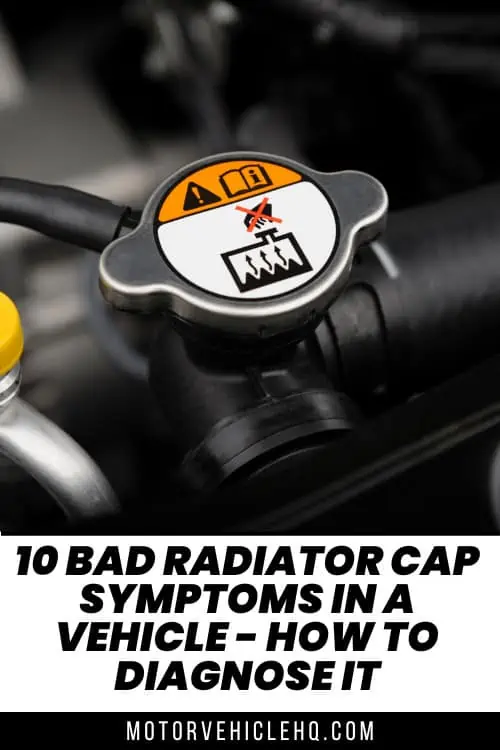

Nyangano Maurice specializes in vehicle troubleshooting and has more than 10 years of experience in the automobile industry. Over many years of experience as a car mechanic, he has acquired a broad range of skills, including engine repair, brake systems, electrical systems, and more. He frequently hosts community workshops and training programs to help motor vehicle owners understand their vehicles better.

